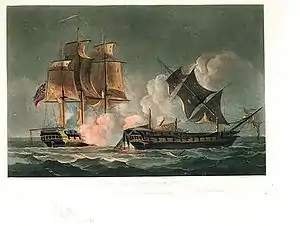Hubert Le Loup de Beaulieu
Hubert Le Loup de Beaulieu,[1][2][3] often written Beaulieu-Leloup,[4] ( ? — Forte, Gulf of Bengal, 1 March 1799) was a French Navy officer. He was a cousin to Louis Garneray.[5]
Career
Early life
He served as second ensign on the East Indiaman Comte de Provence from 1763 to 1764,[6] and as first enseign on the chartered corvette Sage armed for Mauritius on 1 May 1766.[1]
In 1776, he commanded the merchantman Carnate for a journey from Indian to China.[2]
Sercey's squadron
In 1796, Beaulieu-Leloup served in the Navy in Rochefort with the rank of Commander.[5] He commanded the frigate Forte[7] in Sercey's squadron.[7]
In September 1797, Sercey had him relieved of his command and he was replaced by Captain Ravenel,[8] but reinstated on the insistence of Mauritius governor Malartic,[note 1] who caved in to pressure from the Colonial Assembly and sent Prudente and Forte to engage in independent commerce raiding off Bengal, disturbing Sercey's plans.[9] Sercey was furious, and wrote to the Ministry of the Navy:
General Malartic knew that I intended not to leave such an important command as that of Forte in the hands of Captain Beaulieu, whose age and weariness have weakened the faculties.[10]
On 24 February 1799, Forte engaged the East Indiaman Osterley.[11] After the battle, Beaulieu-Leloup, deeming the fire from Forte to strike too low, ordered her guns raised by diminishing their quoins by 2.7 cm.[11]
Battle with HMS Sybille

In the evening of 27 February 1799, she captured the East Indiamen Endeavour and Lord Mornington;[12] unbeknownst to Beaulieu-Leloup, the flashes of the battle were spotted by the 38-gun HMS Sybille, under Captain Edward Cooke, which closed in to investigate.[12] She was spotted by the officers of Forte and identified as a British frigate,[4] but Beaulieu-Leloup insisted that she was another East Indiaman and sent his crew to sleep for the night.[4] It was only when Sybille's intent to intercept became evident that Beaulieu-Leloup called to battle stations;[4] even then, he closed in and ordered a restrained attack, firing his guns one by one to test his opponent.[4][12]
Cooke reserved his fire and manoeuvered into a raking position before delivering a broadside into the stern of Forte.[4][12] In the damage, confusion and smoke caused by Sybille's fire, Forte began to mistakenly fire her starboard battery at one of her own prizes,[4] leaving Sybille free to come about and deliver a second raking broadside from her other battery.[12] The two frigates then began trading broadsides at close range, mortally wounding Cooke at 1:30;[12] ten minutes later, Beaulieu-Leloup was killed by a cannonball.[4][7]
After Beaulieu-Leloup's death, command of Forte passed to Lieutenant Vigoureux, who was killed himself at 2:00.[11] Lieutenant Luco took over and attempted to manoeuver Forte, but her entire rigging collapsed, putting an end to her resistance.[11] Sybille hailed to inquire whether Forte had struck, and ceased fire when this was confirmed.[11] The next morning, Sybille hoisted a French flag to deceive the prize crew on Endeavour and Lord Mornington and recapture the ships, but the ruse was foiled and the two East Indiamen escaped.[10]
Notes and references
Notes
- Hennequin (p.210) proved a glimpse of Sercey's reluctance by referring to Beaulieu-Leloup as an "inept old man".
References
- Role du Sage (1769)
- Papers from the ships Iris (Captain Pinatel) and Carnate (Captain Le Loup de Beaulieu).…, National Archives
- Traité des Assurances, p.62
- Troude, p.171
- Garneray, p.7
- Role du Comte de Provence (1763)
- Fonds Marine, p.231
- Troude, p.55
- Troude, p.129
- Troude, p.173
- Troude, p.172
- Lardas, "Sybille vs Forte"
Bibliography
- Arnault, Antoine-Vincent (1827). Biographie nouvelle des contemporains [1787-1820] (in French). 4.
- Émerigon, Balthazard-Marie (1783). Traité des Assurances (in French). 2. J. Mossy.
- Garneray, Louis (2007). Voyages, aventures et combats: Mémoires (in French). La Découvrance. ISBN 9782842655471.
- Hennequin, Joseph François Gabriel (1835). Biographie maritime ou notices historiques sur la vie et les campagnes des marins célèbres français et étrangers (in French). 2. Paris: Regnault éditeur.
- Lardas, Mark (20 May 2013). "Sybille vs Forte". British Frigate vs French Frigate 1793–1814. Osprey Publishing. ISBN 9781780961347.
- Troude, Onésime-Joachim (1867). Batailles navales de la France (in French). 3. Challamel ainé.
- Fonds Marine. Campagnes (opérations ; divisions et stations navales ; missions diverses). Inventaire de la sous-série Marine BB4. Tome premier : BB4 1 à 482 (1790-1826)
- Gilbert Buti, Philippe Hrodej (dir.), Dictionnaire des corsaires et pirates, CNRS éditions, 2013